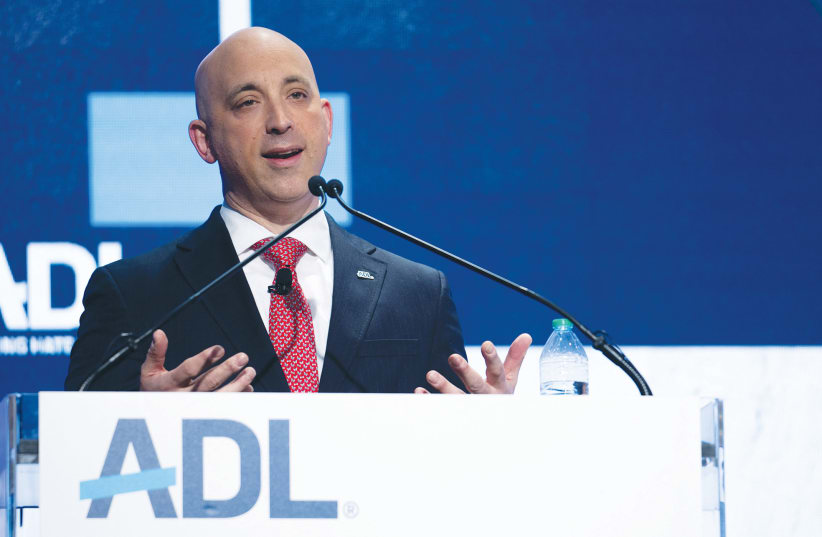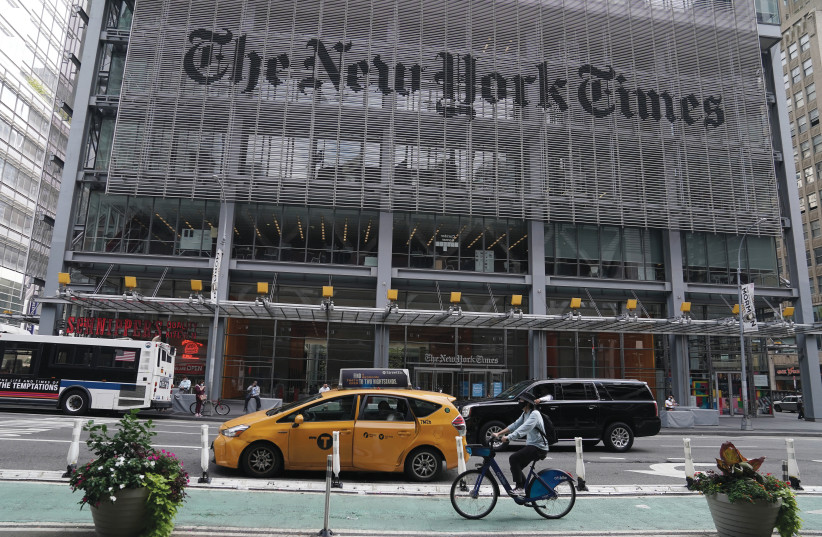Many managers of large organizations and companies, as well as politicians, need to deal with criticism on a daily basis. They must decide what criticism is legitimate and what should be ignored for various reasons. But when criticism begins to trickle out into other groups, usually the smart CEOs and politicians begin to reevaluate the situation.
If I were editor-in-chief of The New York Times, I would definitely begin a deep and intense cleanse and interrogation into why Jewish leaders from all backgrounds think that The Times has been causing a violent wave of antisemitism as result of the skewed way they’ve been reporting on the ultra-orthodox community.
When it comes to the recent dramatic debate between The Times and haredi (ultra-orthodox) Jews in the United States, slowly more and more non-orthodox institutions have begun reacting negatively to their coverage. It’s not only the usual orthodox organizations who have been speaking up against the newspaper but also many from mainstream Jewish organizations and even those that can be considered left-wing.
The New York Times and the bias against ultra-Orthodox Jews
As a reminder, in recent years, The Times has published a number of articles that have been accused of perpetuating negative stereotypes about ultra-orthodox Jews.
One example is an article published in 2019 about a measles outbreak in New York City. The article focused on the ultra-orthodox community, which had a high rate of unvaccinated children. The article also quoted a number of people who expressed negative views about this community, such as one resident who said that he wiped public bus seats and crossed the street when he saw ultra-orthodox Jews.
Another example is an article published in 2020 about the ultra-orthodox community’s response to the COVID-19 pandemic. The article focused on the community’s reluctance to follow public health guidelines, such as social distancing and mask-wearing. The article also quoted a number of people who expressed negative views about the ultra-orthodox community, such as a public health official who said that the community was putting everyone at risk.
These are just two examples of The Times’s anti-ultra-orthodox reporting. In recent years, The Times has published a number of other articles that have been accused of perpetuating negative stereotypes about the ultra-orthodox community. These articles have been criticized for being biased, unfair and harmful. Orthodox organizations have speculated that the Pulitzer Prize was considering giving the prestigious award to the journalists who have worked on this series. But on Monday, Pulitzer announced the winners of the 2023 awards, while the journalists from The Times who have reported about ultra-orthodox Jews weren’t even nominated.
Jonathan Greenblatt, the CEO of the Anti-Defamation League (ADL) and one of the most visible and prominent leaders of Jewish-American Jewish organizations addressed the claims of antisemitism in The Times reporting, during his keynote speech at the ADL National Leadership Summit, last week. He said that a situation where you see “This [ultra orthodox] community singled out by elite institutions, like The New York Times, arguably the most important paper in the world, depicting them as clannish and using power to manipulate events... that represents an antisemitic attack on their community.”
“This [ultra orthodox] community singled out by elite institutions, like The New York Times, arguably the most important paper in the world, depicting them as clannish and using power to manipulate events... that represents an antisemitic attack on their community.”
Jonathan Greenblatt
GREENBLATT REMINDED the audience that in 2022, Brooklyn was the epicenter of antisemitic assaults, with 52 distinct attacks. He continued by stating that “the hate crimes that we see in Brooklyn, attacking the Haredi community, are despicable. Our orthodox brothers and sisters are constantly under threat. It is one that needs solidarity and support from everyone, Jewish and non-Jewish alike.”
But Greenblatt agreed that the way orthodox Jews were and are still portrayed by The Times is framing them in a way that tells their readers that this group is different. It is okay to be afraid of them. He shared that he and his staff implored The Times behind the scenes because this framing encourages more antisemitism.
Greenblatt isn’t an orthodox Jew and has been considered to be very critical of former president Donald Trump in what he saw as an administration that wasn’t doing enough regarding combating antisemitism. Greenblatt isn’t considered by anyone as being too conservative and is definitely not a member of a hasidic community.
The Times’ anti-ultra-Orthodox reporting is not only harmful to the ultra-orthodox community but it is also harmful to the Jewish community as a whole. The Times is a major news organization and its reporting has a significant impact on public opinion. When The Times publishes negative articles about the ultra-orthodox community, it contributes to the spread of antisemitism.
Similarly, the conservative The Daily Signal news website recently published an investigative report on a number of the articles written about the haredi community. “The Times reported that students with disabilities increased from 12% to 59% at Yeshiva Beth Hillel of Krasna after [former mayor] Bill de Blasio’s reform,” The Daily Signal wrote, adding that, “Krasna administrators say that only 18% of their students receive special education services and that they shared documentation of this with The Times. They also noted that The Times sent their 59% figure to the school on the afternoon of the Thursday before Christmas, asking for comment by 9 a.m. on Monday, December 26. This made it impossible for the school to contact the Department of Education, which was closed, to try to understand how a third party could review their data and arrive at that statistic,” they concluded that “The Times wrote only that the school disputed its figure.”
The Daily Signal gave an additional example of what they see as problematic reporting. They relate to a The Times report stating that at 25 of the city’s approximately 160 Hasidic yeshivas, more than half the students are classified as needing special education, whereas in public schools, one in five students is classified as having a disability.
Journalist Tony Kinnett wrote that the most relevant number to the question of whether Hassidic students are overrepresented in special education is the percentage of Hasidic students who are classified as having a disability. The Times did not print that number. Specifically, community leaders from several schools claim the number of active users of special education/accommodations for people with disabilities sits close to 20%, while both The Times and Rosenthal directly refused to provide any comment regarding any number.
GREENBLATT ISN’T the only representative of the old-school mainstream Jewish organizations that spoke up against The Times. The Jewish Community Relations Council (JCRC) released a formal statement in March 2023, in reaction to The Times coverage of the Hasidic Jewish community: “We are concerned about a pattern that has emerged in The New York Times coverage of the haredi community, including the Hasidic community, in recent years. Stories dealing with this community have often painted a distorted and stereotyped picture, one that lacks broader context about this highly complex community, including the positive aspects of haredi social structure. The cumulative effect of The New York Times’ negative coverage of the Haredi community comes against the background of escalating antisemitic trends in this city and country and is likely to reinforce stereotypes of both Jews generally and the Haredi population in particular.” The JCRC added that they in no way are suggesting that important or critical stories go unreported but that they believe that The Times has a responsibility to ensure its coverage of the Haredi community is fair-minded, accurately nuanced and contextualized, just as it should be for all communities in New York. The JCRC is another mainstream liberal Jewish institution that has fought for many minorities in the past and most of its members aren’t part of the orthodox community, far from it.
In April, Agudath Israel of America, a 100-year-old umbrella group representing Orthodox Jews in America, sent a letter to The Pulitzer Prize Committee, urging them not to give an award to The Times reporters for the series about orthodox Jews.
The report was published under the banner of its newly formed division, KnowUs, which is intended to be a pro-ultra-orthodox lobby and proactive media player in the US. They wrote that “the articles have breached numerous standards of journalistic ethics.” They added that “The Times has misused this incredible power and the victims of this reporting – orthodox and Hasidic Jews in New York – are a marginalized minority already subject to a rising, frightening number of hate crimes.
On Tuesday, KnowUs published a statement saying that “While there is no way of knowing with certainty why the much-ballyhooed series did not receive a Pulitzer Prize, the news that The Times was not awarded for its one-sided and erroneous portrayals of orthodox and hasidic Jews was greeted with much appreciation and relief in orthodox Jewish circles.”
Even the heads of the Pulitzer Prize understand that The Times coverage of Orthodox Jews is a serious problem. It fuels antisemitism and makes it more difficult for orthodox Jews to live in peace and security. The Times needs to do more to ensure that its coverage of orthodox Jews is accurate and fair.
The editors and publishers of this legacy newspaper need to listen to the criticism and decide if they want to continue creating enemies within the Jewish community or rather acknowledge that there have been issues that are being looked into. The heads of Jewish organizations have urged them to stop spreading hate and stop demonizing an entire community that may need to be criticized at times but also represents many beautiful Jewish values.
The writer is the Jewish world analyst for The Jerusalem Post.

